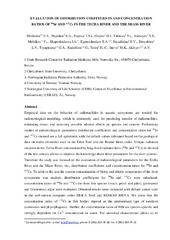| dc.contributor.author | Shishkina, Elena A. | |
| dc.contributor.author | Pryakhin, Evgeny A. | |
| dc.contributor.author | Sharagin, Pavel A. | |
| dc.contributor.author | Osipov, D.I. | |
| dc.contributor.author | Tryapitsina, Galina A. | |
| dc.contributor.author | Atamanyuk, Natalia I. | |
| dc.contributor.author | Egoreichenkov, E.A. | |
| dc.contributor.author | Trapeznikov, A.V. | |
| dc.contributor.author | Rudolfsen, G. | |
| dc.contributor.author | Teien, H.C. | |
| dc.contributor.author | Sneve, M.K. | |
| dc.date.accessioned | 2020-01-13T09:11:21Z | |
| dc.date.available | 2020-01-13T09:11:21Z | |
| dc.date.issued | 2019-02-10 | |
| dc.description.abstract | Waterborne radioactive releases into the Techa River from the Mayak Production Association in Russia during 1949–1956 resulted in downstream contamination of the river ecosystem. The discharged liquid waste contained both short-lived isotopes (95Zr, 95Nb, 103,106Ru, 141,144Ce, 91Y, 89Sr and 140Ba with half-life from 3 days to 1.02 years) and the long-lived 90Sr and 137Cs (half-life - 28.79 y and 30.07 y, respectively). Even now, when two half-lives of 90Sr and 137Cs have passed, the contamination in the upper river region (about 70 km from the source of releases) is still relatively high. Current anthropogenic dose rates calculated for the fish of the Techa River depend on the distance along the stream and decrease from 150 to 3 μGy day−1. Radiation exposure of fish is expected to have been much higher at the time of the releases. The aim of the study was to evaluate the dose rates for the most common fish species of the river, viz., roach (Rutilus rutilus), perch (Perca fluviatilis) and pike (Esox lucius), in the period of peak contamination of the upper reaches of the Techa River from 1950 to 1951. To achieve this objective, calculation of both internal and external dose rates was performed. For dose rate calculation, the contamination of the river compartments was modeled, body-size dependent dose coefficients were evaluated, morphometric data were analyzed. Maximum dose rates were obtained for roach; minimum – for pike, it depends on fish lifestyle (time spent at the bottom). In the period before September 1950, fish of the upper reaches are assessed to have been exposed to dose rates exceeding the screening level equal to 240 μGy day−1. From September 1950 up to the end of 1952 the fish dose rates along the Techa River were found to be close to the UNSCEAR threshold equal to 9.6 × 103 μGy day−1 or even much more higher (up to 1.9 × 105 μGy day−1). Extremely high historical dose rates did not lead to the difference in fish size and fish growth rate currently observed in the Techa River and in the comparison waterbody (the Miass River). Discussion includes the description of radiation effects observed currently in the river fish. Today the effects observed in hematopoietic system may be the consequence of radiation exposure of fish over several generations. For example, long term dwelling of fish in the radioactively contaminated environment leads to their adaptation to chronic radiation exposure. At the same time, an increase their sensitivity and decrease their adaptive capacity to respond to other stress factors can be observed. | en_US |
| dc.identifier.citation | Shishkina, E.A., Pryakhin, E.A., Sharagin, P.A., Osipov, D.I., Tryapitsina, G.A., Atamanyuk, N.I., Egoreichenkov, E.A., Trapeznikov,A.V., Rudolfsen, G., Teien, H.C., Sneve, M.K. (2019) The radiation exposure of fish in the period of the Techa river peak contamination. <i> Journal of Environmental Radioactivity, 201</i>, 43-55. | en_US |
| dc.identifier.cristinID | FRIDAID 1704630 | |
| dc.identifier.doi | 10.1016/j.jenvrad.2019.01.016 | |
| dc.identifier.issn | 0265-931X | |
| dc.identifier.issn | 1879-1700 | |
| dc.identifier.uri | https://hdl.handle.net/10037/17075 | |
| dc.language.iso | eng | en_US |
| dc.publisher | Elsevier | en_US |
| dc.relation.journal | Journal of Environmental Radioactivity | |
| dc.relation.projectID | Andre: Norwegian Radiation Protection Authority | en_US |
| dc.rights.accessRights | openAccess | en_US |
| dc.rights.holder | Elsevier | en_US |
| dc.subject | VDP::Technology: 500::Environmental engineering: 610 | en_US |
| dc.subject | VDP::Teknologi: 500::Miljøteknologi: 610 | en_US |
| dc.title | The radiation exposure of fish in the period of the Techa river peak contamination | en_US |
| dc.type.version | acceptedVersion | en_US |
| dc.type | Journal article | en_US |
| dc.type | Tidsskriftartikkel | en_US |
| dc.type | Peer reviewed | en_US |


 English
English norsk
norsk